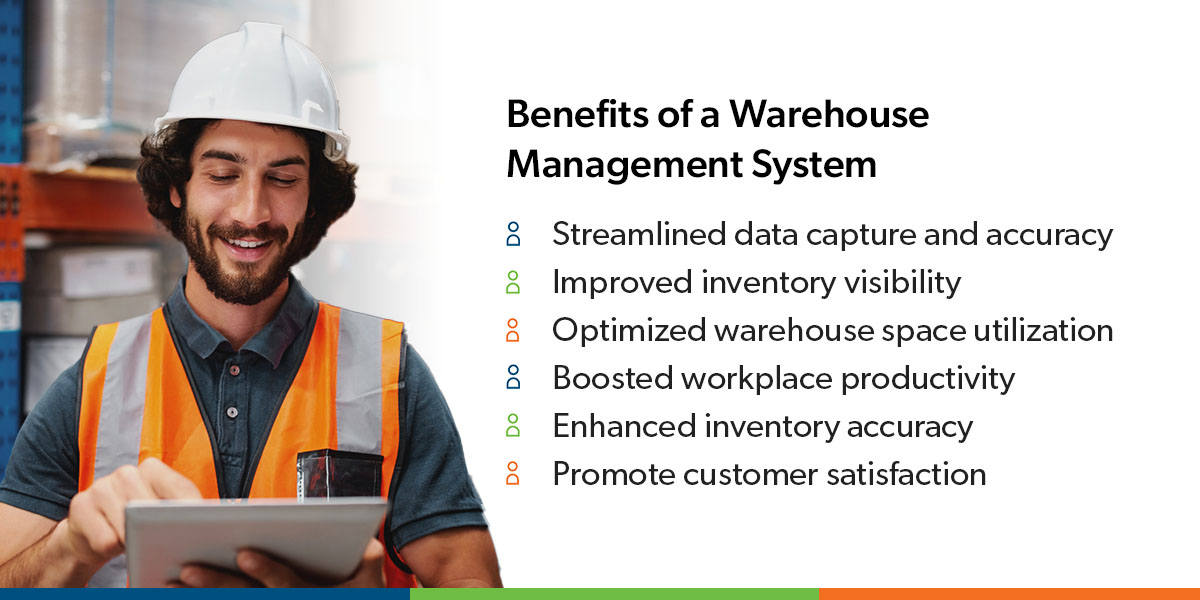In today's fast-paced business environment where supply chain management plays a vital role, having a comprehensive warehouse management system (WMS) is essential for streamlining operations and maximizing productivity.
So, what is a warehouse management system? Simply put, it is a powerful tool that enables effective control and management of various activities within a warehouse. A WMS is the backbone of your distribution center, helping you efficiently manage inventory, track shipments and ensure seamless order fulfillment.
But what does a warehouse management system do for your operations? Primary warehouse management system functions facilitate the smooth movement and storage of goods within a warehouse. From receiving and put-away to packing and shipping, a WMS oversees and optimizes every step of the warehouse process. It shows real-time information into inventory levels, automates workflows and enhances accuracy in order fulfillment.
Types of Warehouse Management Systems
WMS comes in various types and implementation methods tailored to different organizations' specific needs and characteristics. Understanding the different types of warehouse management systems is crucial for selecting the most suitable solution for your business.
Standalone WMS
Standalone WMS are independent software solutions solely focused on managing warehouse operations. These systems offer comprehensive functionalities for inventory management, order fulfillment and logistics tracking. They are highly customizable and scalable, allowing organizations to tailor the system to their unique requirements.
Cloud-Based WMS
Cloud-based WMS are gaining popularity due to their flexibility and scalability. These systems are hosted on remote servers, accessible through a web-based interface. Cloud-based WMS eliminates the need for on-premises infrastructure and provides easy access to real-time data from any location. They offer rapid deployment, automatic updates and cost-effective subscription models.
Supply Chain Modules
Some organizations opt for WMS that is part of a broader supply chain management suite. These systems incorporate WMS functionalities alongside other modules, such as transportation management, demand planning and supplier relationship management. Integrated supply chain modules provide end-to-end visibility and coordination across various aspects of the supply chain.
ERP-Integrated Systems
WMS integrated with enterprise resource planning (ERP) platforms offer a seamless flow of information and processes between the warehouse and the organization's overall operations. This integration enables real-time synchronization of inventory, orders and financial data. Integrated WMS-ERP systems enhance efficiency by eliminating data silos and streamlining department communication.
The Difference Between a Warehouse Management System and an Inventory Management System
When it comes to managing warehouse operations and inventory, two critical systems play distinct but interconnected roles — the WMS and the inventory management system (IMS). While they share similarities in their focus on inventory, fundamental differences set them apart.
WMS
A WMS is designed to oversee the storage, movement and optimization of items within a warehouse or distribution center. It ensures goods are stored in the most efficient locations and accurately tracks their movement from receiving to picking, packing and shipping. WMS also plays a critical role in managing labor operations and monitoring employee performance, ensuring tasks are assigned effectively and productivity is maximized.
IMS
IMS is primarily focused on tracking and managing inventory levels across different stages, from raw materials to finished goods. They provide insights into stock on hand, including raw components needed for manufacturing final goods and work-in-progress inventory. Inventory management systems help businesses maintain optimal stock levels, generate purchase orders when supplies are low and ensure a smooth production process.
Inventory Management vs. Warehouse Management
The key differences between these systems lie in their scope and complexity. While inventory management systems concentrate on stock levels and materials required for production, WMS encompasses broader functions. WMS handles inventory and orchestrates the movement of goods within the warehouse, optimizes storage, coordinates labor tasks and monitors overall warehouse performance.

Benefits of a Warehouse Management System
Implementing a WMS offers a range of significant benefits that can positively impact your supply chain operations. Let's explore some warehouse management system benefits:
- Streamlined data capture and accuracy: A WMS connected with the Internet of Things (IoT) automates data capture processes, replacing manual entry with barcode scanning and real-time updates. This streamlines operations, reduces errors, and ensures accurate inventory tracking and order fulfillment. By eliminating manual data entry, you minimize the risk of human error and enhance data integrity.
- Improved inventory visibility: With a WMS, you gain visibility into inventory levels, item locations and movement throughout the warehouse. This enables better inventory control, reduces stockouts and overstock situations, and improves the accuracy of demand forecasting. Enhanced visibility allows you to make data-driven decisions and optimize inventory replenishment strategies.
- Optimized warehouse space utilization: A WMS enables efficient space utilization by organizing inventory based on demand and storage requirements. It helps identify suitable locations for different products, reducing unnecessary travel and maximizing storage capacity. By optimizing space utilization, you can accommodate more inventory, minimize congestion and enhance warehouse efficiency.
- Boosted workplace productivity: WMS functionalities, such as task management, automated picking and packing, and optimized routing, streamline warehouse operations and enhance productivity. By automating manual tasks and providing clear instructions to employees, a WMS reduces errors, minimizes downtime and boosts workplace productivity.
- Enhanced inventory accuracy: Accurate inventory management leads to efficient order fulfillment and customer satisfaction. A WMS improves inventory accuracy by providing real-time visibility, automating inventory reconciliation and minimizing stock discrepancies. With precise inventory information, you can meet customer demands promptly, reduce order fulfillment errors and minimize stockouts.
- Promote customer satisfaction: A WMS contributes to a seamless customer experience by improving inventory visibility, accuracy and order fulfillment speed. You can meet customer expectations and enhance satisfaction with faster order processing, accurate inventory information and timely deliveries. Satisfied customers are more likely to become repeat customers and advocate for your brand.
Intelligent WMS and logistics management systems based on machine learning (ML) can further benefit companies by optimizing inventory management, reducing operational costs, improving supply chain visibility, and enhancing overall efficiency and decision-making processes.
How to Choose the Right WMS
Selecting the right WMS solutions impacts your organization's operational efficiency and bottom line. To make an informed choice, consider these factors:
- Assess your budget: Consider both upfront costs, such as software licenses and hardware, as well as ongoing expenses, including maintenance and support. Understanding your budgetary constraints will help you narrow your options and focus on solutions aligning with your financial capabilities.
- Identify critical functions: Every business has unique requirements, so prioritize capabilities that will bring the most value to your operations. For example, if inventory accuracy is a top concern, look for a WMS solution that offers robust inventory management features. Consider your needs, such as demand forecasting, order fulfillment, labor management or integration with other systems and evaluate potential WMS solutions accordingly.
- Research vendors and solutions: Look for reputable vendors with a track record of success and positive customer reviews. Evaluate their offerings and compare them based on features, scalability, implementation process, customer support and value for your investment.
- Consider scalability: As your business grows, your WMS needs may change. Consider whether the WMS can accommodate increased inventory volumes, additional warehouses or distribution centers and changing operational needs. A scalable WMS will allow you to adapt and grow without significant system overhauls in the future.
- Seek demonstrations and references: Request live demonstrations of the WMS solutions you are considering. This will give you a firsthand look at the system's user interface, functionality and ease of use. Additionally, ask for vendor references and reach out to existing customers to gain insights into their experience with the solution and the vendor's level of support and responsiveness.
Get a Fully Integrated WMS With The Vested Group
A warehouse management system improves inventory visibility, optimizes warehouse space utilization, enhances inventory accuracy and promotes customer satisfaction. To harness these benefits and take your warehouse management to the next level, partner with The Vested Group, which offers the NetSuite Warehouse Management System.
With the NetSuite WMS, you achieve a cloud-based, end-to-end solution that scales effortlessly and provides real-time insights across departments. As NetSuite's 2022 Partner of the Year, The Vested Group offers expert implementation, support and customization services. Our knowledgeable team is committed to your success, getting you up and running with NetSuite WMS in as little as 60 days.
Contact The Vested Group to learn more about implementing NetSuite WMS.







